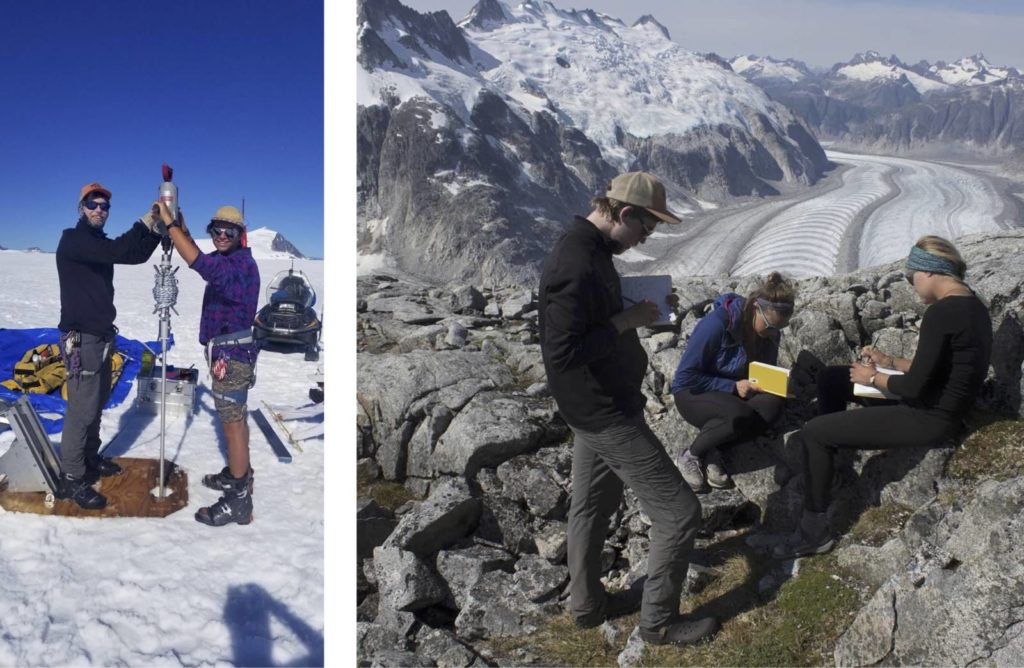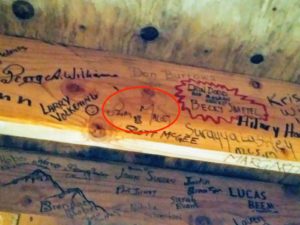For over 70 years the Juneau Icefield Research Program (JIRP) has run an eight-week field research expedition on the glaciers spanning Juneau, Alaska and Atlin, British Columbia. JIRP is the longest continuous glacial monitoring program in North America. But what truly sets the program apart is its commitment to active student participation and mentorship: all of the summer research is carried out by students, ranging from high schoolers to Ph.D. candidates, and mentored by field staff and faculty from around the world.
Active participation and mentorship are vital aspects of all student research. In my experience, I learn way more from engaging with research in the real world than from reading, listening to lectures, or completing recipe-type lab exercises. So, when I got the opportunity to join JIRP this summer, I jumped at the chance.

As a student researcher on JIRP, I worked as a member of the glacial mass balance team, measuring the 2018 snow accumulation and ice melting across the Taku Glacier. The main outlet glacier draining the Juneau Icefield, the Taku is one of the largest glaciers studied in Alaska. For years, the Taku had been relatively insensitive to climate change thanks to most of its area being located at high elevation where it receives abundant snowfall each winter. But now, like its neighbors, it is in decline.
Measuring the mass balance of the Taku Glacier requires an enormous effort. Located in the interior of the Coast Range, the glacier is accessible only by ski or by helicopter. The first few weeks of JIRP we spent learning the technical skills necessary to safely traverse the icefield: telemark skiing on a rope team, crevasse rescue, self-arresting with an ice axe. On the traverses from Juneau to JIRP’s Camp 10 on the Taku Glacier we hiked up mountain ridges, picked our way through icefalls and crevasses, and skied across tens of miles of glaciers.

From our camp on the main branch of the Taku, we skied up to fifteen miles to study sites where we dug 2-4 meter deep snow pits to measure annual accumulation. Remote study sites on the northwest branch of the Taku required a three-day ski to reach. With other students on the mass balance trip, I planned and led the three-day trip. This test of student glacial travel, safety management, and research ability is a key component of JIRP’s curriculum.

This emphasis on student engagement is complemented by JIRP’s commitment to mentorship. The seeds of the program trace all the way to John Muir’s trip to Alaska in 1890. Muir’s partner, glaciologist Harry Reid, mentored Bill Field, who brought a young assistant with him to the icefield in 1941. That assistant, Maynard Miller, founded JIRP and inspired generations of climate scientists, geologists, and explorers on the icefield. Their signatures adorn the wood rafters of the buildings at camps across the icefield, from Steven Squyres, the head of the Mars Land Rover project, to my thesis adviser, GEO professor Adam Maloof.
The remote expeditionary setting on JIRP creates a close knit and collaborative community, where students are shoulder to shoulder with faculty mentors nearly all the time. Most of what I learned from the faculty was through conversations outside of structured lecture times, during meals, ski traverses, safety training, and long sunsets. Living together with faculty for weeks means that they are not just academic mentors, but role models. The opportunity to build genuine relationships with and learn from faculty in such close environment was one of the highlights of the summer.
Student research spans many disciplines and takes many forms. For most of you, glacier mountaineering will not be a part of your research experience–and your research may not even focus on the natural world at all! However, I think the JIRP approach to research education is relevant to any Princeton student.
JIRP’s educational philosophy is defined by a synthesis of three ideals: nature, books, and action. Nature represents the primary source of our knowledge—the world around us. Books represent knowledge, transferred from mentor to student. Action represents engagement with the world–the quest for knowledge. Action is the source of growth, discovery, and inspiration. Through books (mentorship) and action (active engagement in research), we understand nature (the world around us).
Like many of my JIRP peers, before this summer I had never done any glacial research and I could not ski. And JIRP was one of the most rewarding research experiences I have ever had. If you are also looking for a great research experience, prioritize opportunities for mentorship and active engagement.
–Alec Getraer, Natural Sciences Correspondent

